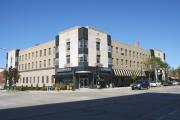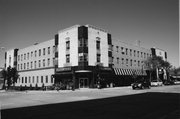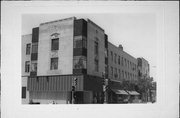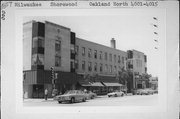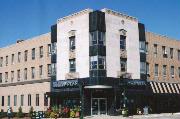Property Record
4001-4015 N OAKLAND AVE
Architecture and History Inventory
| Historic Name: | ARMORY COURTS BUILDING |
|---|---|
| Other Name: | North Shore Apartments |
| Contributing: | |
| Reference Number: | 8857 |
| Location (Address): | 4001-4015 N OAKLAND AVE |
|---|---|
| County: | Milwaukee |
| City: | Shorewood |
| Township/Village: | |
| Unincorporated Community: | |
| Town: | |
| Range: | |
| Direction: | |
| Section: | |
| Quarter Section: | |
| Quarter/Quarter Section: |
| Year Built: | 1930 |
|---|---|
| Additions: | |
| Survey Date: | 2008 |
| Historic Use: | apartment/condominium |
| Architectural Style: | Art Deco |
| Structural System: | |
| Wall Material: | Limestone |
| Architect: | Martin Tullgren and Sons |
| Other Buildings On Site: | |
| Demolished?: | No |
| Demolished Date: |
| National/State Register Listing Name: | Not listed |
|---|---|
| National Register Listing Date: | |
| State Register Listing Date: |
| Additional Information: | A 'site file' exists for this property. It contains additional information such as correspondence, newspaper clippings, or historical information. It is a public record and may be viewed in person at the Wisconsin Historical Society, Division of Historic Preservation-Public History. DECO TERRA COTTA PANELS. This building was constructed as the Armory Courts Building. It was given this name because it was on the site of the old National Guard Cavalry Armory. IT was built in 1930-31 and was a late commission for the firm of Martin Tullgren and Sons, still operating with son Herbert Tullgren after the deaths of both his father Martin and brother Minard in 1922 and 1928, respectively. 2008- "Known today as the North Shore Apartment building, this large commercial/apartment building was designed by the architectural firm of Martin Tullgren and Sons, specifically by Herbert Tullgren, the only member of the firm still living at that time. It is a very large, three-story corner building that is primarily constructed of tan bricks. But its comer storefront entry pavilion and two side entry pavilions are decorated with fine Art Deco details. The two elevations that are "public" are the east and south elevation, with the south elevation having the main address. The west and north elevations are the "back" of the building and are irregular and undecorated. As stated above, the three entry pavilions anchor the building. In between are simple walls of tan brick with a narrow cornice of a running pattern of stylized sunrises. These walls have symmetrical fenestration of individual openings filled with steel-frame windows made up of two vertical lights over a horizontal light on the second and third stories. These are replacements for the original windows that are seen in an older photograph. The first story of the south elevation is also punctuated with openings filled with steel frame windows with two vertical lights. On the east elevation, the first story between the entry pavilions is filled with several business storefronts that feature large glass show windows in metal frames and black glazed terra cotta tiles. The central entry pavilion has a first floor corner storefront framed with black-glazed terra cotta tiles, metal framed show windows, and a recessed main entrance with a modem double metal and glass door topped with an arched transom. The entrance walls are covered with black terra cotta and above the entrance is a round steel band. Photographs from 1980 show that, at that time, the upper portion of the storefront was enclosed with large metal panels and the show windows were mostly covered with composite concrete panels. The current appearance is likely a recent renovation that, unfortunately, altered the windows. Above the comer storefront there are two large smooth limestone two-story panels. They are decorated at the cornice with stylized swags, and medallions with a bird motif. On the second and third stories there are two openings that are currently filled with the same type of windows seen elsewhere on the building. The windows are decorated on the third story with a curved arch and a horizontal stylized low-relief sunburst A flat fluted pilaster runs down one side of both windows and meets a curved faux shallow "balcony" incised with horizontal lines under the second story window. The spandrel in between has a panel with a low-relief figural decoration. Flanking each limestone panel are columnated windows clad above and below with terra cotta tiles. The windows are similar to those of the rest of the building, but are larger in size. At the corner, the window column is doubled due to the convergence of the two limestone panel sections. The entry pavilion at the west end of the south elevation of the building is decorated in an identical manner on the second and third stories. But it descends down to the first floor to flank an entrance. The terra cotta of the window columns also extends down to meet with the terra cotta clad foundation. The entrance has a modern metal and glass entry door with modern sidelights and transom. There are four single pane windows flanking each side of the entrance. The entry pavilion at the north end of the east elevation is similar to the one described above, except the limestone panel is much wider. The same type of terra cotta window columns flank the limestone panel. But the windows are different. In this panel there are three shallow arched openings only on the third floor that are filled with the three-light modem windows seen in the rest of the building. This entry pavilion was specifically designed for a bank and the decoration in the limestone panel reflects the banking purpose. In between the stylized swags of the cornice is a running coin motif of a Lincoln Head Penny and the reverse of the Buffalo Nickel, a Native American Chief. At the center of the limestone panel, above the third story windows, there is a carved panel with a slightly projecting larger coin motif, the Buffalo Nickel. The entrance of this pavilion is larger than the one on the south elevation and features a double metal and glass door with sidelights and a very large transom surrounded by more terra cotta tiling. Two single light windows flank this entrance on the first story." - "E Capitol Dr, Estabrook Pkwy to Lake Dr", WisDOT ID #2025-12-011", Prepared by Carol Lohry Cartwright (2008). |
|---|---|
| Bibliographic References: | Architecture/History Survey. October 2008. Prepared by Carol Lohry Cartwright. |
| Wisconsin Architecture and History Inventory, State Historic Preservation Office, Wisconsin Historical Society, Madison, Wisconsin |

